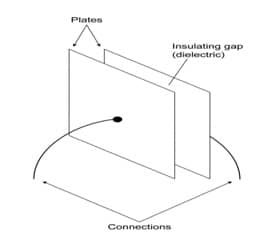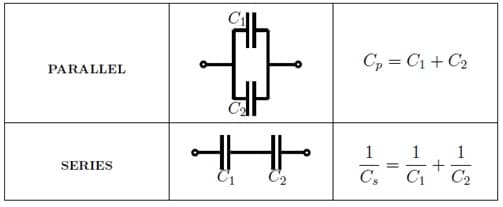The word capacitance is derived from capacity, capacity is to contain, or store. a capacitor refers to a device that is capable of storing electrical energy. Unlike the storage of water which can be stored in ponds, lakes, tanks and our seas which are our almost unlimited reservoir of water we have very limited options for direct storage of electrical energy. As a matter of fact, we have only one option as a battery to store electrical energy in the form of chemical energy and is not a direct method. This phenomenon of energy storage and then release finds lots of use in electrical and electronic circuits. Capacitors are available in a very wide range and sizes, but functionally all are used for storage of electrical charge. Here instead of going into details of a specific capacitor, we shall limit ourselves to the general principal/construction of capacitors.
What is a Capacitor?
The capacitor is a device that is capable of storing electric charge +ve and -ve both. Due to this charge, a potential difference gets created between the terminals. And a capacitor behaves like a battery. Their size varies from a small bead type used in electronic circuitry and large ones used for power factor improvement in power circuitry.

Capacitor
Construction of a Capacitor
Basically, a capacitor consists of two parallel conductive plates separated by insulating material. Due to this insulation between the conductive plates, the charge/current cannot flow between the plates and is retained at the plates.
The plates may be of different shapes like rectangle, square, circular, and can be made into different shapes like a bead, disc, or cylindrical type by always maintaining constant insulation level between the plates. The size of these capacitors depends on their power handling capacity.

Simple Form of Capacitor Diagram
The simplest form of capacitor diagram can be seen in the above image which is self-explanatory. The shown capacitor has air as a dielectric medium but practically specific insulating material with the ability to maintain the charge on the plates is used. It may be ceramic, paper, polymer, oil, etc.
In order to charge the capacitor, it has to be connected across a voltage source and the charging current will continuously flow to the capacitor till it is fully charged. Once it is fully charged it by itself becomes a voltage source.
Also, have a look at the adjacent image to see how a small cylindrical capacitor will look like. It may, however, be added that very small and large capacitors may come in different shapes and sizes. Most of the capacitors are multilayer capacitors so that even in a small size we can accumulate a greater amount of charge. The unipolar capacitors can only be used in dc while bipolar can be used in dc and ac. The capacitor is properly sealed externally so that no ingress takes place. The body of each capacitor is marked for its capacity, voltage, and polarity. It is built to withstand mechanical shocks.
The Basic Circuit of Capacitors
The image below is showing a simple circuit to show how capacitor charging and discharging takes place in a circuit. As the changeover switch moves towards the battery positive terminal the positive charges start accumulating on the positive plate of the capacitor with equivalent negative charge accumulating on the negative plate and this goes on till the capacitor voltage matches the battery voltage. Now as we move the changeover in such a way that it gets connected to the negative plate the battery gets open-circuited and the resistance gets connected across the capacitor. Since a charged capacitor behaves like a voltage source it gets discharged through the resistance.

Circuit Diagram
Capacitor Symbol
Each country and standard have their own way of denoting capacitors, however, the most common are given hereunder.

Capacitor Symbols
Working Principle of a Capacitor
As we know that when a voltage source is connected to conductor it gets charged say by a value Q. And since the charge is proportional to the voltage applied, we can say that:
Q∝V
In order to equate the charge Q and voltage V.
Q=CV, where C is the capacitance of the conductor.
C=Q/V, the value of C is dependent on various factors as given hereunder.
- The plate/conductor area. Larger the plate area greater is the charge accumulation on it.
- The gap between the plates. With a large gap between the plates, the capacitance gets reduced due to a reduction in charge binding/field force or reduction in permittivity.
- The dielectric medium. The value of capacitance can increase if we use a material with high permittivity. As an example, the relative permittivity of air is approximately= 1, while that of glass/ceramic is approximately more than 7.
All these factors are of utmost importance while designing a capacitor. The mathematical expression for the same is:

Mathematical Expression of Capacitor
The energy stored in a capacitor is given by the formula: Q=CV and W=CV²/2. This is also known as Capacitor Formula.
It may be added here that in order to achieve desired capacitance a series and parallel combination can be used as shown in the image below where Cp is the resultant capacitance in parallel and Cs is the resultant capacitance in series.

The capacitor in Series and Parallel
Capacitance Measurement
The standard unit of capacitance is Farad, named after scientist Michael Faraday.
1 Farad=1 coulomb/volt
Farad is a very large unit, in practice, we generally use smaller units like Nano farads, Pico farads, Micro farads, etc.

Capacitance Measurement
Capacitor Applications
Capacitors are used in almost every field of electronics, and play a very significant role in power circuits as well. Depending on the application we may use different types of capacitors for different applications.
- In electronics, we use capacitors for filters, oscillators, and tuned circuits, and for these applications mostly ceramic capacitors due to their superior dielectric properties.
- Capacitors can also be used as timing devices as the charging and discharging time can be predetermined using RC time constant.
- Capacitors are used as radiofrequency coupling/blocking and decoupling / bypassing devices.
- Capacitors are also used for smoothing device for various wave generators and frequency converters/inverters and are also used where the switching frequency is high.
- Capacitors are used as voltage dividers and multipliers.
- As holding device capacitors are able to retain the voltage/value even if there is an interruption in supply.
- For the protection of various power electronic devices capacitors are used in snubber circuits.
- Capacitors play a significant role in noise filtering. Film type capacitor is suitable for this application.
- All analog to digital converters has capacitors as the most important component. Electrolytic capacitors may be used for this application.
- Various ignition systems also use capacitors for high ignition voltage.
- In an electric system, the capacitor plays an important role in power factor improvement which not only increases the active power but also increases the life of switchgear.
- Capacitors are also used to provide an alternative source of direct current supply (Emergency supply) for tripping in the event of main battery failure.
- Capacitors are also used as phase splitter in single-phase alternating current motor. The aluminum electrolytic capacitor is most suitable for this application.
Please refer to this link to know more about Capacitor MCQs.
Thus, this is all about an overview of the capacitor, used in multiple electronic applications. To think of an electronic gadget without capacitor is next to impossible. In power applications, their role as power factor improver is significant. However, as a power storage device, they have yet to play a great role due to their power to volume ratio being low. In the future, we may see many strides being made in this direction. An increase in the use of electric vehicles will also augment research in this direction.